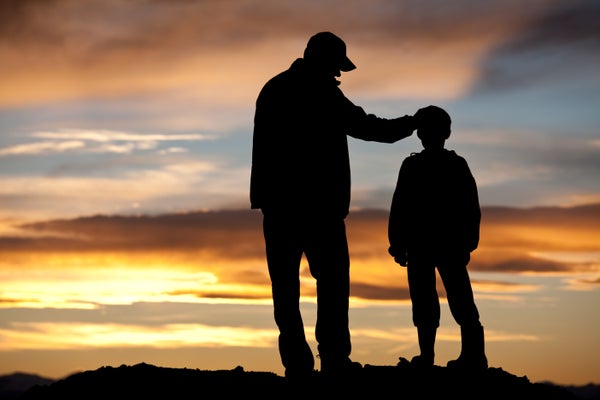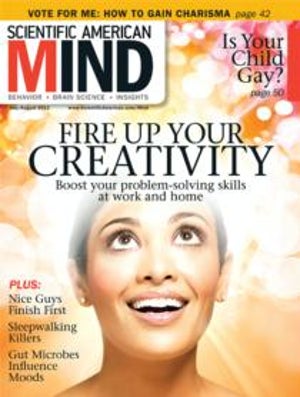
Is Your Child Gay?
If your son likes sissy stuff or your daughter shuns feminine frocks, he or she is more likely to buck the heterosexual norm. But predicting sexual preference is still an inexact science

Excerpted from Why Is the Penis Shaped Like That? … And Other Reflections on Being Human, by Jesse Bering, by arrangement with Scientific American/Farrar, Straus and Giroux, LLC (North America), Transworld Ltd (UK), Jorge Zahara Editora Ltda (Brazil). Copyright © 2012 by Jesse Bering.
We all know the stereotypes: an unusually light, delicate, effeminate air in a little boy's step, an interest in dolls, makeup, princesses and dresses, and a strong distaste for rough play with other boys. In little girls, there is the outwardly boyish stance, perhaps a penchant for tools, a square-jawed readiness for physical tussles with boys, and an aversion to all the perfumed, delicate trappings of femininity.
These behavioral patterns are feared, loathed and often spoken of directly as harbingers of adult homosexuality. It is only relatively recently, however, that developmental scientists have conducted controlled studies to identify the earliest and most reliable signs of adult homosexuality. In looking carefully at the childhoods of gay adults, researchers are finding an intriguing set of behavioral indicators that homosexuals seem to have in common. Curiously enough, the age-old homophobic fears of many parents reflect some genuine predictive currency.
If you're enjoying this article, consider supporting our award-winning journalism by subscribing. By purchasing a subscription you are helping to ensure the future of impactful stories about the discoveries and ideas shaping our world today.
J. Michael Bailey and Kenneth J. Zucker, both psychologists, published a seminal paper on childhood markers of homosexuality in 1995. Bailey and Zucker examined sex-typed behavior—that long, now scientifically canonical list of innate sex differences in the behaviors of young males versus young females. In innumerable studies, scientists have documented that these sex differences are largely impervious to learning. They are also found in every culture examined. Of course, there are exceptions to the rule; it is only when comparing the aggregate data that sex differences leap into the stratosphere of statistical significance.
The most salient differences are in the domain of play. Boys engage in what developmental psychologists refer to as “rough-and-tumble play.” Girls prefer the company of dolls to a knee in the ribs. Toy interests are another key sex difference, with boys gravitating toward toy machine guns and monster trucks and girls orienting toward baby dolls and hyperfeminized figurines. Young children of both sexes enjoy pretend play, but the roles within the fantasy context are gender-segregated by age two. Girls enact the role of, say, cooing mothers, ballerinas or fairy princesses, and boys prefer to be soldiers and superheroes. Not surprisingly, therefore, boys naturally select other boys for playmates, and girls would much rather play with other girls.
So on the basis of some earlier, shakier research, along with a good dose of common sense, Bailey and Zucker hypothesized that homosexuals would show an inverted pattern of sex-typed childhood behaviors—little boys preferring girls as playmates and becoming infatuated with their mother's makeup kit; little girls strangely enamored of field hockey or professional wrestling—that sort of thing. Empirically, the authors explain, there are two ways to investigate this hypothesis, with either a prospective or retrospective study. Using the prospective method, young children displaying sex-atypical patterns are followed into adolescence and early adulthood so that their sexual orientation can be assessed at maturity.
This method is not terribly practical for several reasons. Given that a small proportion of the population is homosexual, prospective studies require a large number of children. This approach also takes a long time, around 16 years. Finally, not a lot of parents are likely to volunteer their children. Right or wrong, this is a sensitive topic, and usually it is only children who present significant sex-atypical behaviors who are brought into clinics and whose cases are made available to researchers.
Rough-and-Tumble Girls
For example, in a 2008 study psychologist Kelley Drummond and her colleagues interviewed 25 adult women who were referred by their parents for assessment at a mental health clinic when they were between three and 12 years old. At the time, all these girls had several diagnostic indicators of gender identity disorder. They might have strongly preferred male playmates, insisted on wearing boys' clothing, favored rough-and-tumble play, stated that they would eventually grow a penis or refused to urinate in a sitting position. Although only 12 percent of these women grew up to be gender dysphoric (the uncomfortable sense that your biological sex does not match your gender), the odds of these women reporting a bisexual or homosexual orientation were up to 23 times higher than would occur in a general sample of young women. Not all tomboys become lesbians, of course, but these data suggest that lesbians often have a history of cross-sex-typed behaviors.
And the same holds for gay men. Bailey and Zucker, who conducted a retrospective study in which adults answered questions about their past, revealed that 89 percent of randomly sampled gay men recalled cross-sex-typed childhood behaviors exceeding the heterosexual median.
Critics have argued that participants' memories may be distorted to fit with societal expectations and stereotypes. But in a clever study published in 2008 in Developmental Psychology, evidence from childhood home videos validated this retrospective method. People blindly coded child targets on the latter's sex-typical behaviors, as shown on the screen. The authors found that “those targets who, as adults, identified themselves as homosexual were judged to be gender nonconforming as children.”
Numerous studies have since replicated this general pattern, revealing a strong link between childhood deviations from gender role norms and adult sexual orientation. There is also evidence of a “dosage effect”: the more gender-nonconforming characteristics there are in childhood, the more likely it is that a homosexual or bisexual orientation will be present in adulthood.
Not all little boys who like to wear dresses grow up to be gay, nor do all little girls who despise dresses become lesbians. Many will be straight, and some, let's not forget, will be transsexuals. I was rather androgynous, showing a mosaic pattern of sex-typical and atypical behaviors. In spite of my parents' preferred theory that I was simply a young Casanova, Zucker and Bailey's findings may account for that old Polaroid snapshot in which 11 of the 13 other children at my seventh birthday party are little girls. But I wasn't an overly effeminate child, was never bullied as a “sissy” and, by the time I was 10, was indistinguishably as annoying, uncouth and wired as my close male peers.
On the Monkey Bars
In fact, by age 13, I was deeply socialized into masculine norms. I took to middle school wrestling as a rather scrawny 80-pound eighth grader, and in so doing, ironically became all too conscious of my homosexual orientation.
Cross-cultural data show that prehomosexual boys are more attracted to solitary sports such as swimming, cycling and tennis than they are to rougher contact sports such as football and soccer; they are also less likely to be childhood bullies. In any event, I distinctly recall being with the girls on the monkey bars during recess in second grade while the boys were in the field playing football and looking over at them, thinking to myself how that was rather strange. I wondered why anyone would want to act that way.
Researchers readily concede that there are quite likely multiple—and no doubt extremely complicated—developmental routes to adult homosexuality. Heritable, biological factors interact with environmental experiences to produce sexual orientation. Because the data often reveal very early emerging traits in prehomosexuals, children who show pronounced sex-atypical behaviors may have more of a genetic loading to their homosexuality, whereas gay adults who were sex-typical as children might trace their homosexuality more directly to particular childhood experiences.
Then we arrive at the most important question of all. Why do parents worry so much about whether their child may or may not be gay? All else being equal, I suspect we would be hard-pressed to find parents who would actually prefer their offspring to be homosexual. Evolutionarily, parental homophobia is a no-brainer: gay sons and lesbian daughters are not likely to reproduce (unless they get creative).
But bear this in mind, parents, there are other ways for your child to contribute to your overall genetic success than humdrum sexual reproduction. I don't know how much money or residual fame is trickling down to, say, k. d. lang, Elton John and Rachel Maddow's close relatives, but I can only imagine that these straight kin are far better off in terms of their own reproductive opportunities than they would be without a homosexual dangling so magnificently on their family trees. So cultivate your little prehomosexual's native talents, and your ultimate genetic payoff could, strangely enough, be even larger with one very special gay child than it would be if 10 mediocre straight offspring leaped from your loins.
If researchers eventually perfect the forecasting of adult sexual orientation in children, would parents want to know? I can say as a once prehomosexual pipsqueak that some preparation on the part of others would have made it easier on me, rather than constantly fearing rejection or worrying about some careless slipup leading to my “exposure.” It would have at least avoided all those awkward, incessant questions during my teenage years about why I wasn't dating a nice pretty girl (or questions from the nice pretty girl about why I was dating her and rejecting her advances).
And another thing: it must be pretty hard to look into your prehomosexual toddler's limpid eyes, brush away the cookie crumbs from her cheek and toss her out on the streets for being gay.
(Further Reading)
Jesse Bering is Associate Professor of Science Communication at the University of Otago in New Zealand. He is the author of The Belief Instinct (2011), Why Is the Penis Shaped Like That? (2012) and Perv (2013). To learn more about Jesse's work, visit www.jessebering.com or add him on Facebook (https://www.facebook.com/jesse.bering).

This article was originally published with the title “ Is Your Child Gay? ” in SA Mind Vol. 23 No. 3 ( July 2012 ) , p. 50
doi: 10.1038/scientificamericanmind0712-50
Learn and share the most exciting discoveries, innovations and ideas shaping our world today.